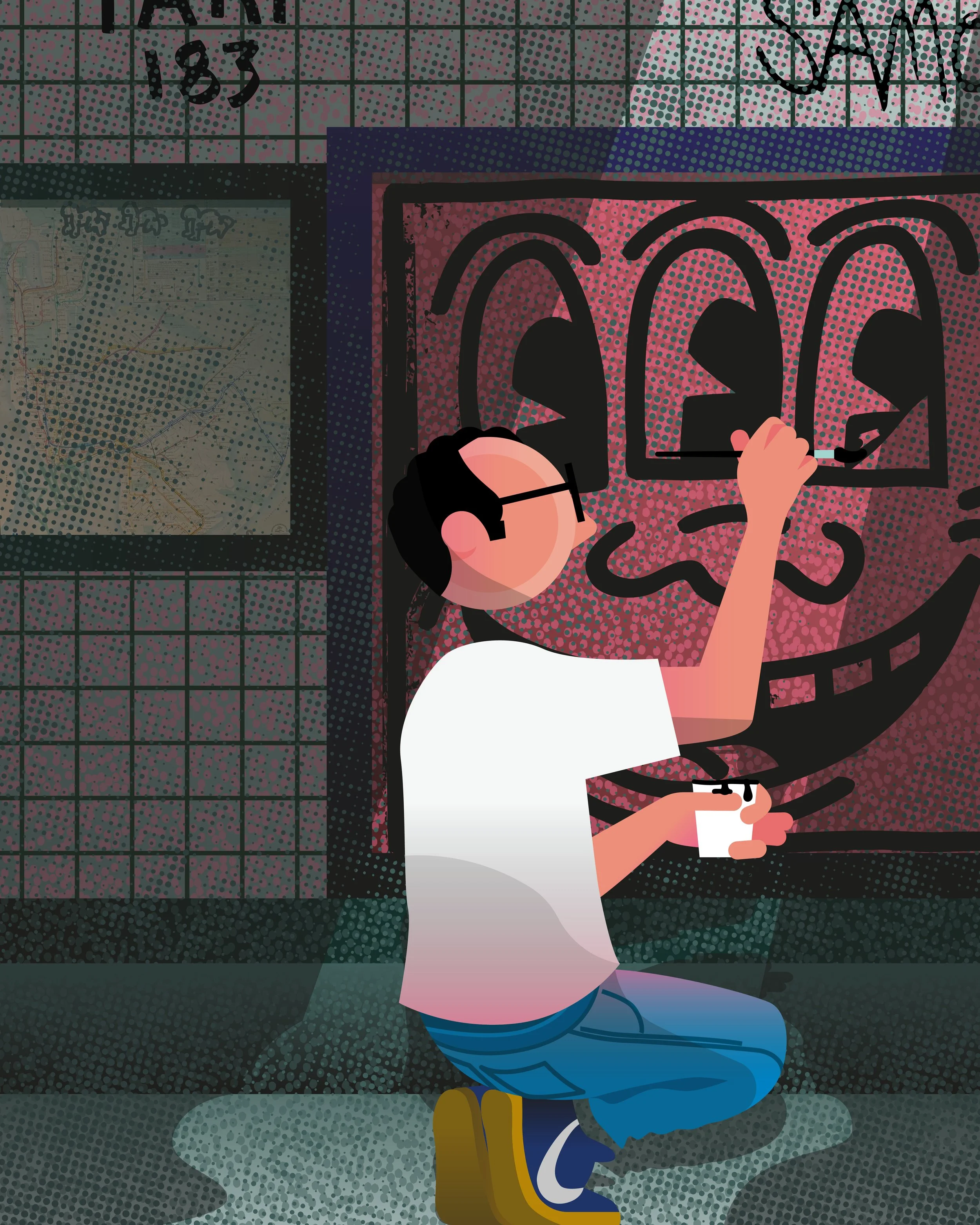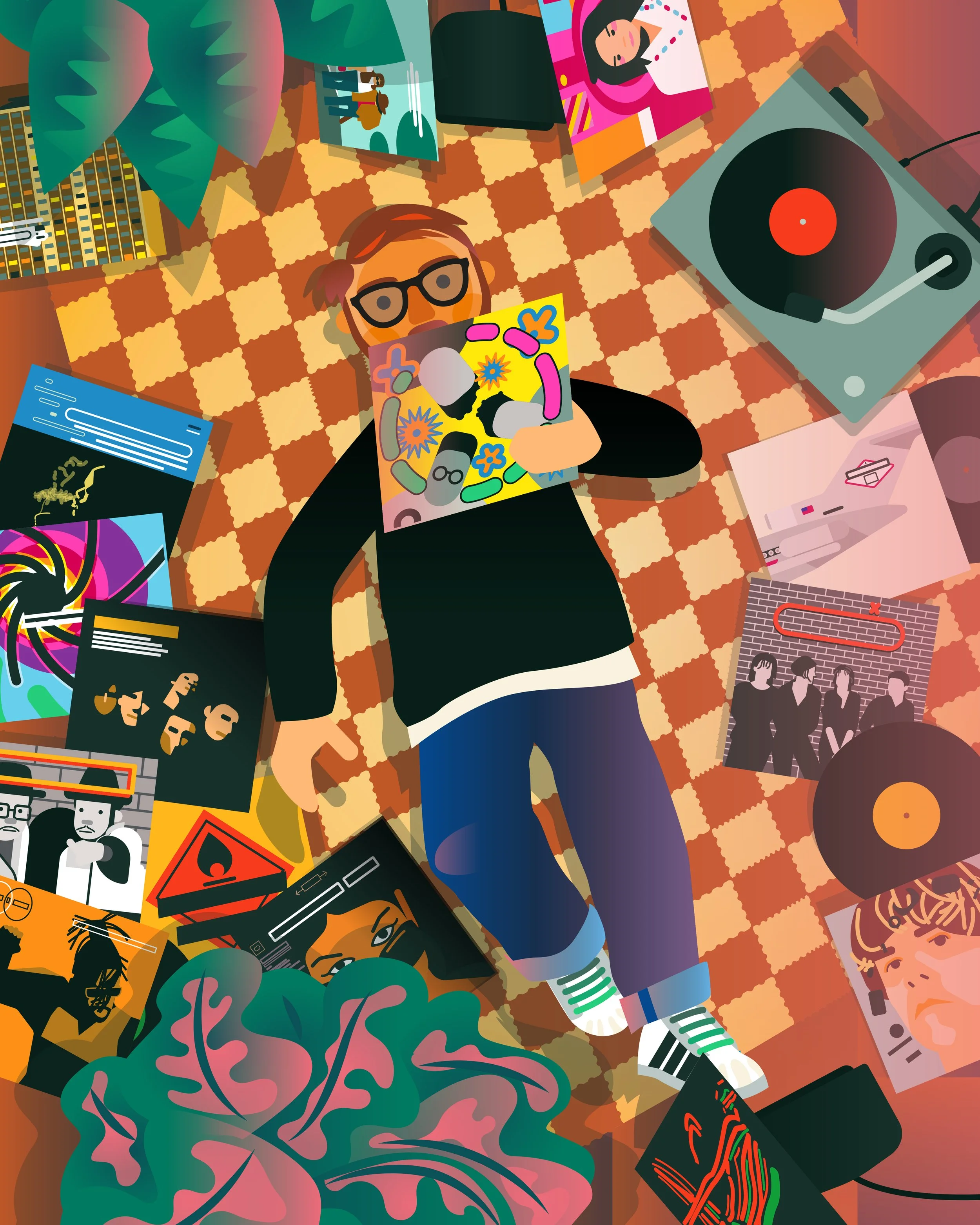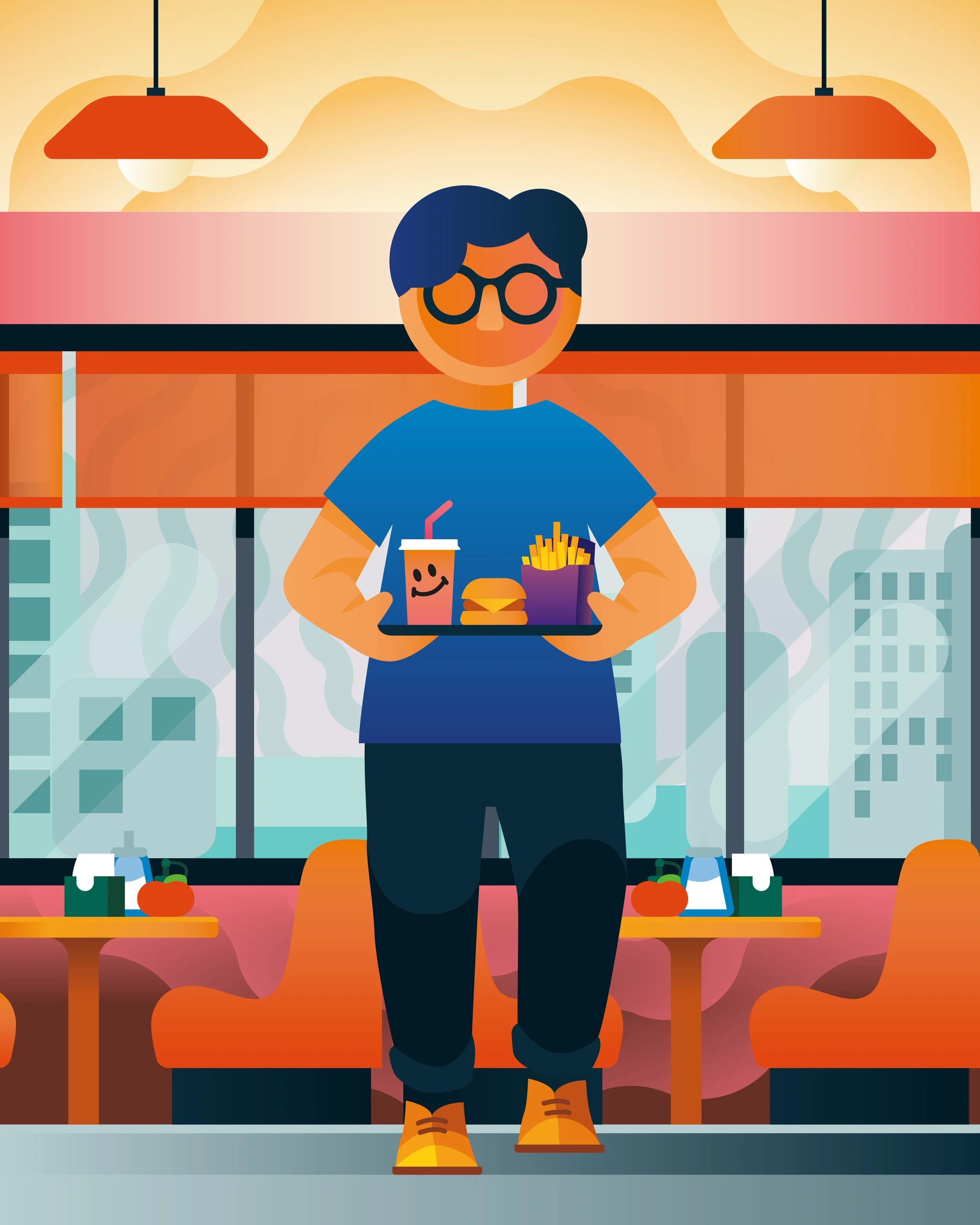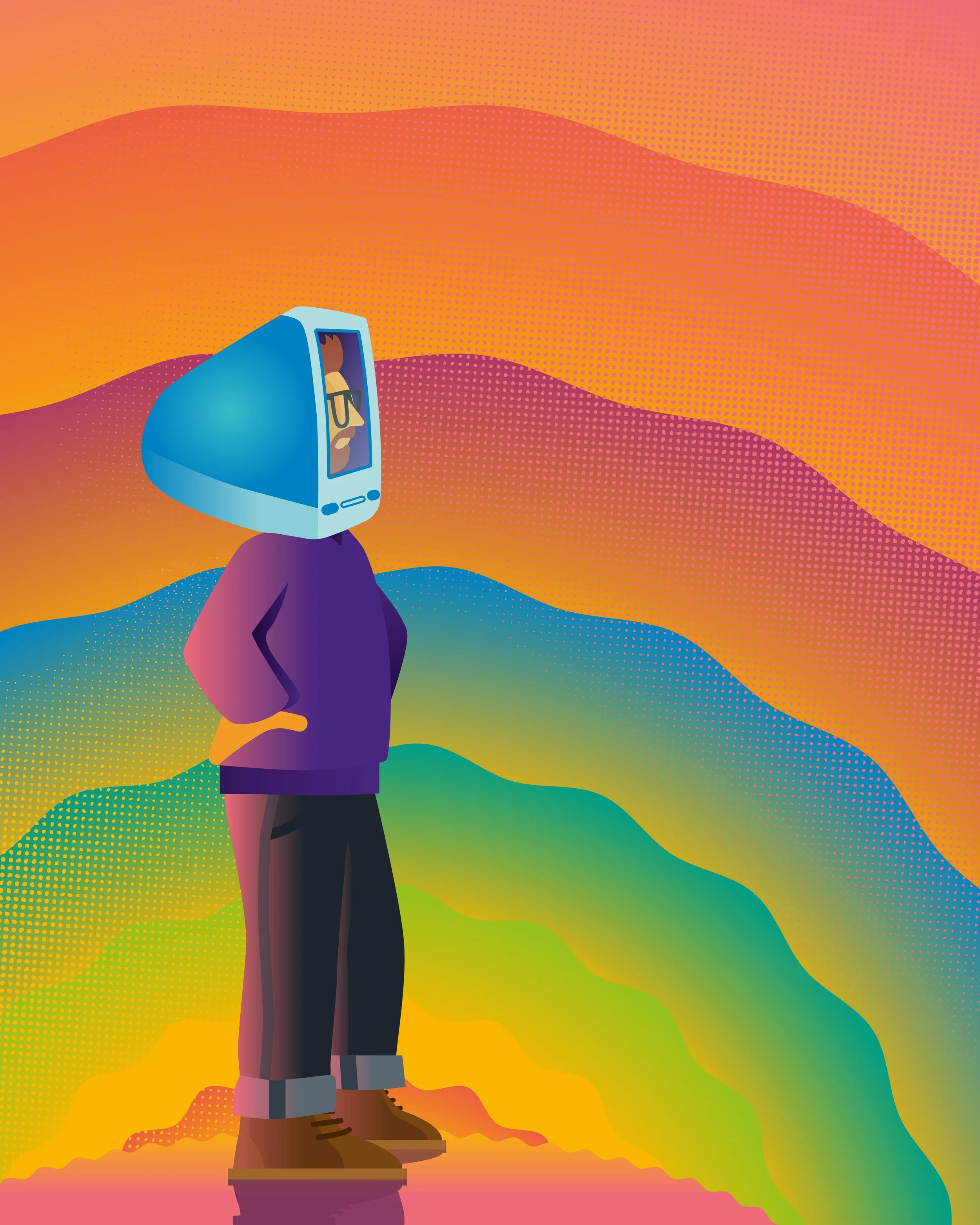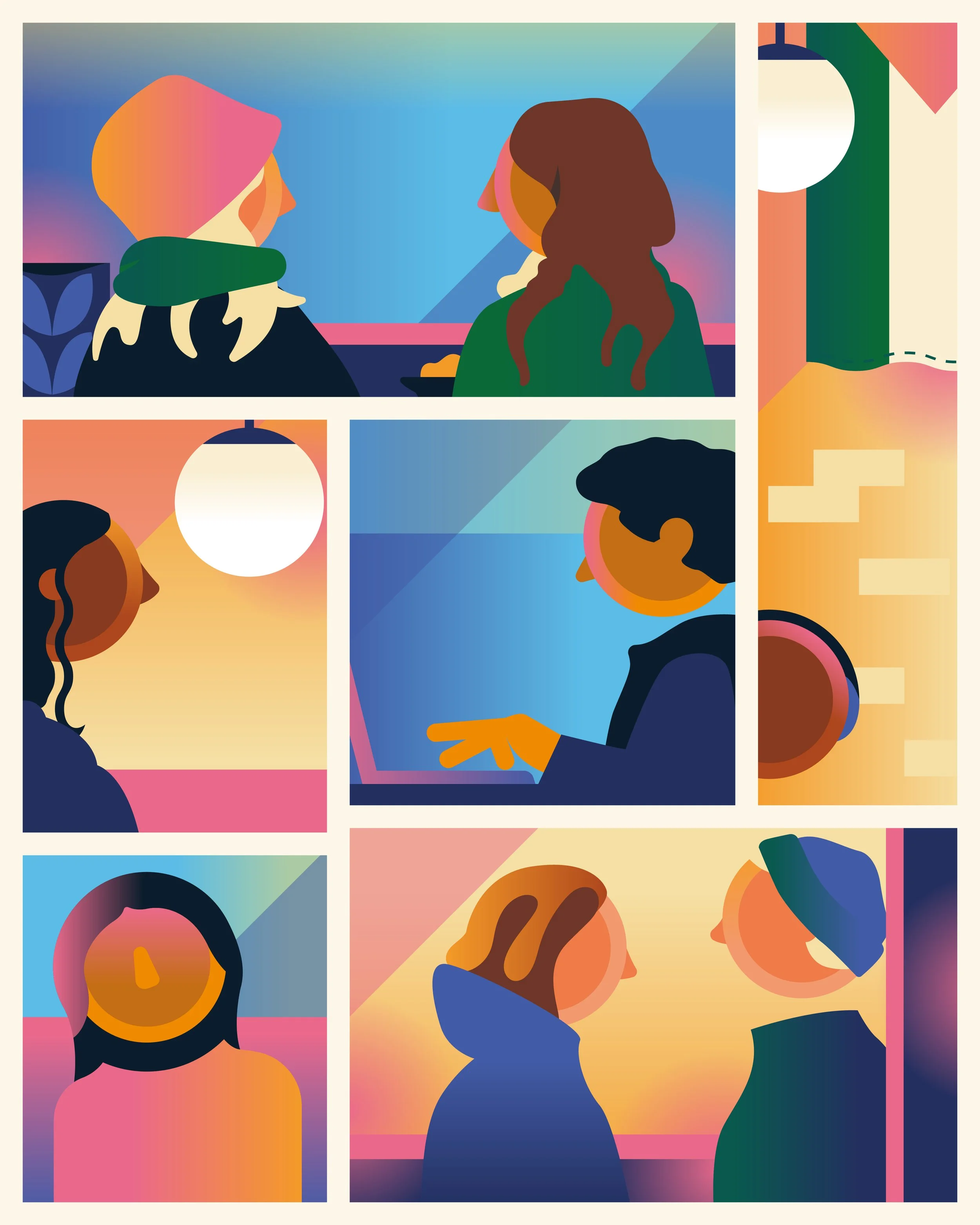THE JOURNAL
Thoughts and experiences from my 20 year illustration career, sit back and enjoy a read.
OPEN.
The next 20 posts and illustrations you’re about to scroll through were all created March 2025, to celebrate ‘Ben the Illustrator’ turning 20 (not me personally, I’m ancient, but it’s 20 years since I started illustrating full-time).
One thing I learnt during this month, by pushing myself to do 20 posts with 20 new illustrations… I feel like I’ve fallen in love with my own illustration work all over again. Finding new things to illustrate, focusing on solid concepts (up yours AI), settling into new colour combinations, maintaining the art of detail, and creating work purely for the enjoyment of creating artwork.
So here it is, my little news stand. Tell your friends, tell your clients, tell your art directors. No really, please do, freelancers rely on word of mouth, and it’s no secret that so many independent businesses are struggling at the moment, as I saw @finestimaginary say recently ‘use us or lose us’!
I’m Ben the Illustrator, I’ve been doing this for 20 years now and I’d love to keep doing it, so if you’re up for a chat or looking to commission, then just get in touch, I’m open.
JUMP ON THE BED.
Grow up, or don’t, it’s up to you. Sometimes you have to grow up a bit, you can’t go acting like a toddler or an American President to get your way, grow up. You have to take on responsibilities as you age, bills, chores, people, pets, grow up. And you need to look after yourself, your heart, your teeth, your eyes, your tummy, grow up. But seriously, from my experience, that’s about it, all the rest is up to you, being ‘immature’ doesn’t have to be a bad thing, jump on the bed, draw a funny face in the dirt, eat fizzy sweets, watch cartoons, bounce around at a gig, get in the water, walk along the top of a wall. People lose an aspect of creativity when they grow up. Losing some kind of naive playfulness or wild imagination as you go through adulthood will never help your creativity, and eventually you’ll just be slow and dry and boring. Stay youthful, for your own health and creativity.
Playing Favourites.
Who’s your favourite, Ben?
It’s Keith Haring, always has been, always will be. I’m not entirely sure the first time I saw his work, in the 80s it was just present (if you were looking in the right places). But I do know the first time I really noticed his work, I was 11, December 1987, Woolworths, the 7” single of ‘Christmas in Hollis’ by my beloved Run DMC. It was the year after they released the seminal Raising Hell, including Walk This Way, I had the cassettes, a poster on my wall (still got the tapes AND the poster). So Run DMC had a new Christmas single out, kinda weird, but looks at that cover, it said so much, with so little, a mother and child, cool type and that fat pen line. Perfect. This is art.
As the years went on and I was discovering myself as a creative, I was also discovering more and more about Keith Haring, his interests and inspirations, his community, his creativity. He passed away in 1990, I cut the articles and obituary out of Dad’s newspaper. At some point my Mum (always supportive of my interest in art, thankfully) bought me a book. Then in 1997 I got the chance to go to New York, coincidentally the same Summer that the Whitney Museum was holding a Keith Haring retrospective, to this day that’s the only time I ever properly cried in a gallery. The greatest.
Looking back.
I came to illustration via animation, I’d worked alone, (mostly in music videos) and as a studio (children’s TV and early days of web advertising), but animation just wasn’t quite right. So I left the studio set-up and named myself Ben the Illustrator. Since then I’ve not looked back, in fact I still get a buzz about illustration now, making pictures is somehow inherent in who I am. My single greatest career achievement is simply surviving. So how have I survived?
Evolution, growing, developing and changing as I go is perhaps the single biggest key to me being able to keep going. My work under the name ‘Ben the Illustrator’ has grown, sometimes becoming simpler, sometimes more detailed, sometimes maturer, sometimes more playful. My portfolio has rolled in all directions depending where I want it to be, and (for me) that’s how I like it. A lot of illustrators and teachers will say that you shouldn’t mix it up too much, but it depends on you, if you want to change… change. You can’t stay excited by something that you’re tired of. In the passed 20 years I’ve also ended up with other portfolios! I’ve worked in a 1950’s advertising style, I’ve built portfolios of hand-painted work and I’ve currently got a second portfolio of line drawn work (Ben Draws). And that’s all ok, it’s been fun, it’s paid bills and it’s kept my head and my hands busy and creative. Growing and mixing it up has enabled me to keep illustrating every day, and that’s perfect.
Practise, Practise, Practise.
Yep, Googled it to make sure I spelt it right. The great Demetri Martin once said “I wish I lived next to Carnegie Hall. Then, if someone asked me how to get to my house, I would just say ‘Practise, practise, practise, and then take a left.’”
I feel that we don’t talk about practising our crafts as visual artists; musicians do, they practise all the time, get together, play a song over and over, meet up with friends and jam, create something special and new. I bet actors do, in front of the mirror, you talkin’ to me? But visual artists? Obviously we’re not saving ourselves up for a one-off performance, but still it’s worth doing. It’s such a common topic amongst illustrators, some people hate drawing bicycles or horses, some hate drawing hands, blah blah blah. So put some time aside and just draw that one thing you hate drawing. That way if a client comes along asking for a horse, or a bicycle, or hands, or all 3, you’re ready, practised and good to go.
Don’t get stuck in an egg timer.
Illustrators have to manage themselves, keeping your pencils sharpened, charging your damn ‘magic’ mouse, planning coffee meet-ups, something about taxes or receipts or something, it’s such a busy life. When it comes to scheduling and deadlines, there’s no one way to do it right, it depends how you like to work, how long you take, what you’re working on etc etc. I’m not going to list amazing time-management apps or some clever alarm system, but here’s some things I’ve always done to make sure I stay on schedule…
Use Monday morning for loose ends, some people might want to do it on Friday afternoons, either way make sure the week ahead is tidy before you jump into it.
Write a To Do list. Obvious, but still. I have my To Do list in Google Notes (Keep, but does anyone call it that?). Having my list there means I can access it on my phone and my computer, wherever I am. I break my To Do list into chunks, urgent-today stuff, next-day stuff, do-it-soon stuff, and this’ll-be-fun-one-day-Ben stuff.
If I have non-work things to do during the week like a doctor’s appointment or an important biscuit, I’ll do it on Wednesdays, that way I always know which day is messy and broken-up by life-commitments, it would be handy if Christmas always fell on a Wednesday but it doesn’t work like that.
Figure out how long it takes you to do tasks; for me rough drawings take half a day max, and colour illustrations take a full day max, just knowing this really helps if someone asks you to do something. Block out your calendar accordingly.
If you’ve ticked everything off and you’re all pleased with yourself, finish early on Fridays, life is calling and you’re missing out.
Expectations!
This came out of a conversation about the business of being an illustrator, it being a profession like any other. Being an illustrator involves contracts, deadlines, price negotiations, scheduling, accounts, communication with clients, and every other aspect of running a business. It’s not always doodling with a coffee and looking out of the window!
I’ve always loved being a commercial illustrator, somewhere between being a fine artist and a design studio, I love working with a client, answering a brief, and creating something that aids their business, whatever it may be. HOWEVER! I was not expecting so much fuss about taxes, I never planned on using this many spreadsheets and I never knew I was going to end up researching engineering, medical science or theatre production in order to meet the needs of clients! That said, I’m glad I have, I’m pleased with the broader business understanding I have and I’m always relishing the chances to learn new things in order to aid my illustration work.
Personal Gains.
I was asked about turning personal projects into profit, and this is something that I’ve had some success in, it’s also something I’ve failed in big time!! As illustrators we all need to do personal work, that’s a given, if you’re purely doing client work for too long you’ll get tired or bored, we got into this game because we love making pictures, so it has to be enjoyed. But taking something you’re doing for enjoyment and building it into something you can also enjoy profiting from can be a challenge. I’m going to use my Cover Versions project as my example, a project I started for fun in lockdown, which became a big part of my business and lead me on to commercial projects I never could have imagined. TIPS!…
Create personal work in the style, industry or subject that you would love to work in, you never know what doors it will open. My CVs enabled me to not only connect with 1000s of music lovers who bought prints, but also legit bands, musicians, labels, turntable manufacturers and cover designers. Music is my first love (even more than any visual art), so for me this was a huge personal success.
Share it as you would a client project. On socials etc no-one really cares if you did something for yourself or for a client, people just want to see good work.
Promo the hell out of it, if you’re selling something new then this is another chance (as good as any epic client project) to get yourself on a design blog, in an art magazine or onto any creative resource you would love to be featured on.
Don’t invest too much money up-front, take it slow. When I started my CVs I had a few covers I wanted to see as prints, but I went in too hard on printing multiples, some sold well… some didn’t. When I ordered prints I had no evidence of what would actually sell, if I’d known or taken pre-orders I wouldn’t have over-ordered on that first batch.
If you’re selling online go easy on the store package, again, take it slow with investment, take advantage of free trials and find services that aid your business (eg. Shopify X Royal Mail connection is fantastic).
Package up your goods, good. With CVs they were sent out in a 12” vinyl sleeve, with a sticker on (inspired by Our Price IYKYK) in cardboard record mailers, customers lapped this up!
Newsletters, mate, if your shop has a mailing list, people who like your products will sign up. You don’t need to commit to a weekly bailout, but you can. For me any time I had a new set of prints or a sale, the newsletter (which wasn’t huge, a few 100 customers) would always guarantee a handful of sales and created a few avid collectors!
Ways of Thinking.
Mindsets, something I find really interesting, I’m into it as much as anyone, a lifelong struggler with depression, a mind that never quite makes sense, creative, self-employed, the works! I’m certainly no therapist, so don’t necessarily have any great tips, I believe in all the usuals… talking to people, meditation, walks, music, movies, anything to escape the moment, can all benefit your mindset, self-development and confidence and reduce your anxieties.
As far as my professional life goes, I have 2 ways of thinking :
1 - Daydreaming. I’ve always been a daydreamer; stories, imagining projects, conceiving huge sculptures in fields while I’m driving, I can’t help it. Colours, characters, places, plants, when your mind is fizzing you have to run with it, come up with anything you can come up with.
2 - Focused. The useful mindset, when your mind feels clear and optimistic, focus on yourself, positive constructive thoughts, planning, don’t try and have some wild creative idea, try and plan your emails or put together a marketing plan, do your accounts or something.
3 - There is no 3. If I’m not feeling the creative daydreamer or the focused tidy boy, then I’m not allowed to think about work, it won’t help me, there’s so many other aspects of life to give your mind to, go help someone, do something domestic, watch a movie, run, do something serious. If you’re worrying, then you’re not in the headspace to consider anything in your career, you need comfort and rest, close the office door and open something more considerate to yourself.
Give yourself advice.
That probably doesn’t make sense, but here goes… sometimes I like to take a step back and look at my work, my business, my clients, and check myself, and consider what’s missing. Don’t just pat yourself on the back and move along. So maybe 15 years ago, I did this, and it’s been the best thing I’ve ever done… for the first 5 years of my career I very rarely drew people, I’d draw buildings and cars and landscapes, I’d spent a year almost exclusively illustrating blossom trees for a great selection of clients. But something was missing, I wasn’t getting certain types of commissions I would have loved to get. Then I was assessing my work and realised that my greatest fear was holding me back… drawing people! I hadn’t yet developed a way of illustrating people that really suited my illustration style, I’d always try and illustrate them too realistically. So I took on the challenge and worked at it, I never shared these experiments, and they’re all lost in time now, but I found a way, draw a circle, head done, then build the rest of the figure from there. Now, 20 years into my career, people are probably my favourite thing to draw, their chunky little fingers and cool hairstyles, their clothing, their shoes, their feet; everything about people, I just love to draw people.
Sweet treats, because you’re worth it.
What are you worth? Loads my friend, remember that. There’s not many professions where you start training under the age of 3, as soon as we got our mitts on crayons, or dunked our fingers in paint, or doodled a cartoon character on a school book, we were off and on the path to becoming an illustrator. I didn’t study illustration at uni, I don’t have a qualification in illustration, but I’ve been learning, experimenting and training myself since I could hold a pencil. A lot of us did, and that’s why we’re worth it.
I’ve spoken to many illustrators over the years who feel undervalued, knowing that anyone feels undervalued is heartbreaking, and I’ve certainly been there more than once. I’m not about to run off a guide to pricing illustration, but simply put, if a job isn’t worth doing, IT ISN’T WORTH DOING. If a potential client doesn’t see the value in commissioned illustration, then leave them to stock, or AI, they’ll learn that bespoke commissions will always be worth it in the long run. Keep looking, there are brands, publishers and design agencies that do understand the value of illustration, go find them. Personally I’d rather find other work (I’ll do graphic design work when it comes, or look at other ways to make an income) than create good illustration for bad budgets.
In the mean time, take it from me… you’re worth it, get yourself a donut.
An Open Letter to Potential Clients
Dear Clients,
I hope you’re well. We, the illustrators, just wanted to get in touch and let you know what we do and what we can bring to your table. We make pictures, that much is obvious; we make pictures in a literally endless assortment of ways, we draw, we paint, we digitally draw and we digitally paint, some of us use scissors and glue, some of us use sharpies, or mechanical pencils or found objects like a shopping list or a dead leaf. But, as illustrators, these pictures are neither the start or the end of it.
Our processes often start with research, we can do that for you, and ideas, solid, brilliant, some would say ‘genius’ ideas. We like to collaborate with you the client, share the development and check we’re all on-track for something brilliant. We’re super fun to work with like that, because we can be really clever and talented, and make pictures you may not have thought of (that’s ok, it’s our job to do that, so you can focus on your own business). And then we make our pictures, and then we can do even more after that, we can add motion, or prepare for printing, or do another picture to go with it, or add text, or print it or adjust it to go on a t-shirt or a mug for your desk, we can do loads of stuff, we’re like fine artists (creative and flamboyant) and designers (clever and technical). We love to solve problems. Our pictures serve functions, they can tell stories or relay information, they can depict a situation or make a statement, they can inform, entertain or advertise, all of which are beneficial to you and your customers, I’m sure.
The limits of illustration are endless, it’s literally everywhere, books, screens, transport, clothing, walls, magazines. Working with a legit human illustrator can solve so many problems, bring so much creativity to your business and (allegedly) give you the ability to fly (or at least your business can). You just have to look at @CREATIVEBOOM @ITSNICETHAT or @CREATIVEREVIEW to see quite how much illustration can benefit a brand, think about it, and get in touch.
See you soon, we’re looking forward to working with you.
Illustrators.
The Best Advice.
No-one: What’s the best piece of advice you’ve ever been given Ben?
Me: Well. A year or two before I became ‘Ben the Illustrator’ I was working as part of a little animation studio in London and touting my wares around to anyone I admired (early 2000s, we were still walking around with printed portfolios and meeting people in their studios). If you were around at the time (hi!) then you’ll know how incredible Airside were, so I got in touch and they invited me in. They were lovely by the way, a whole load of the team watched my animation reel and checked my illustration work. I wasn’t necessarily looking for work, more so just advice and a connection. And I came away with it… the legend Fred Deakin was looking through my work, chatting about digital arts software and said “You just have to really stick your head inside the computer and see what’s possible”. And that was it, digital art was my life, 20something years on and I’m still playing with tools, learning different techniques and pushing myself to see what else is possible.
Incidentally, a few years later we’d finished up our animation studio, I’d called myself ‘Ben the Illustrator’ and I found myself freelancing for Airside, happy days.
No Wizardry Here.
“Pay no attention to the man behind the curtain!”. Yeah right Wiz, Toto caught you red handed, come out from there, you strange little man.
I was recently chatting with a fellow illustrator about the pre-production that goes on in our creative professional lives, the ‘invisible labor’ that we all have to do aside from the act of art-making, especially creating the actual final art that everyone sees. It’s such a misunderstood use of our time, like do people actually know what we’re doing? Shall we tell? Has anyone said "Great illustration! Tell us about the research!” Probably not.
Personally, the pre-production work behind the scenes is some of my favourite tasks; I love researching, I love doodling characters before I figure out who stars in the final work, I love quickly sketching out different options for compositions, before I jump into something ‘proper’, I love planning out my hours down to 15 minutes chunks of… only kidding, and I love experimenting with tools and techniques (although mostly digital, I wish I pushed myself more with pencils and paint and real stuff).
I don’t know if this work behind the curtain is of interest, but it’s there, and we’re all doing it, and above all it’s bringing so much value to our final artworks, so whether we’re public with it or not, it must be respected!
Don’t take talent for granted.
I realised something recently, talent itself isn’t always the most notable factor of a creative. Even when we’re out there talking about someone being a genius or an icon, we can still undermine their creative talent. When I was a kid (in the 1980s), there was all these amazing singers and musicians, we’d see them on tv, our parents would have their records or cassettes, and every one of them was something special. Yet how did we describe them? Stevie Wonder… blind, Kate Bush… scary, Prince… wears purple, kind of weird. Of course we need these differentiating factors, otherwise they’re all simply singer/songwriters. But wouldn’t it be great if these non-creative factors weren’t the first thing that came to mind?!
And, so, what can we learn from this? Maybe it’s not enough to have a portfolio of incredible work, to be making some truly phenomenal creations. Maybe we have to put more of our selves out there for people to remember, our voices, choices, places, faces, smiles, styles, moods, tools, quirks and eccentricities, Give them something human to remember, and then get your portfolio in front of them.
I feel like I need to learn this lesson myself, I’ve always talked myself out of showing aspects of my human self. Although I was featured in the graphic arts film ‘Made You Look’ back in 2015 (it’s on Vimeo if you want to see it), I rarely show myself on camera and stopped being involved in events and talks a long time ago, I’ll admit to often feeling like I have little to be remembered by, perhaps it’s not my decision to make. @msaunders_ink asked recently about me stepping into the video realm, maybe I don’t have a choice to do so!
Pick-Up Monkeys.
So the visual may only make sense if you’re of a certain age, I have no idea, but let’s run with it! Here’s a concept for you… hang together, be in a community, create a scene, because if someone in your community gets picked up, they might bring you along with them.
I’ve always believed this, I actually think of it like a huge piece of fabric laid across the country, and if someone picks up one random pinch of fabric, then everything around it gets lifted too, maybe not as high, but still, everyone is on the up. Like when a tent is laid out flat, then you lift up the middle with the pole, everything around it gets lifted too.
So if you feel part of something, stick with it, and don’t get all jealous (very unhealthy trait in anyone working for themselves btw) if someone else is on the rise, because it could mean the whole community is on the rise too, whether you’re all in the same location, or all working in similar styles, or all pushing in the same industry, hang together like monkeys. And if YOU get picked up? Bring along your gang.
Agents!
Getting representation, such a big topic, but I’ll share my own experiences. Firstly, I have to big up my own agents Mendola Arts in the US and La Suite Illustration in France. I have been represented by both for some years, they work in a way that I like to work with, I feel suited to their rosters and both are easy, solid working relationships, as they should be. Being represented by an illustration agent isn’t an easy way to success, you still have to work hard, you still have to promote yourself and manage yourself in the best way possible. That said, there is some security and support in an illustrator/agent relationship that can strengthen your illustration practice in very positive ways.
I can’t advise everyone on seeking representation, there are differences based on location, size of agency and the industries they might be focused on, but I have been thinking about this a lot, and am currently considering seeking representation in the UK for either my Ben the Illustrator portfolio or my Ben Draws portfolio, so I can share some thoughts on UK agencies… If you’re considering approaching an agency, Step 1 should always be looking through their roster of current artists, could you fill a vacancy? Do they work in the right industries for you? Would your portfolio sit alongside their artists without stepping on anyone’s toes? Step 2 should always be to check out their submission requirements on their site, no-one needs to go delivering boxes of printed work if they only accept submissions via their own online form! Step 3, get to know them, you don’t have to introduce yourself as soon as you find them; following them on LinkedIn, Instagram etc and really considering their tone of voice and how they present themselves, does that suit you and how you work? Can you retain your own creative and professional authenticity while working alongside them? I could write a book on this, but I won’t, all I would say is take your time, show them how good you are, how you manage yourself and how awesome you are to work with.
Shout-out!
OK, I don’t have any great experience or inspiration to throw out today, I just want to ask a question… What’s with all the shout-outs?! I’m referring mostly to LinkedIn and Twitter; recruiters, art directors, producers, assorted individuals posting “Hey! I need an illustrator! Post your portfolio!”. Sometimes I see posts on LinkedIn with literally hundreds or thousands of replies, all the great and good of illustrators available for hire. So I need to know, are these for real? Do those people really have a job to commission? How many of the portfolios do they check out? Has anyone ever got a job out of a broad LinkedIn shout-out like this? What’s going on, and why do we keep jumping on to them?
Incidentally, quick English class, back in 1983 DJ Ralph McDaniels was the first person to knowingly use the phrase ‘shout-out’ on his hip-hop music video show Video Music Box on WLIW in New York City.
Get out.
I love drawing while I’m out and about, travelling, architecture and more than anything else… cafes. I just like the mood you can capture in-situ, way more than you can if you sit at home and draw. There’s a bit of a psychological bump to get over when you start doing this, just to be at ease drawing in public, to pull out a pencil case and sketchbook and feel comfortable enough to create at ease. If you’re giving it a try then maybe start in a place where you’ll either go unnoticed or where the public will be open to you having your little creative time. Don’t join the queue at Greggs in a major train station and start drawing tired, angry people in a rush. Don’t stare at people, it’s weird, even if you’re stealthy, you’re also weird. Also, prep yourself, I have a specific pencil case without too much clutter, mostly just pencils all sharpened and ready, also it’s got a little section for pencil shavings, tidy.
This illustration was originally sketched at the brilliant Cafe Kino in Bristol, 100% recommend!
The people need advice.
From conversations with illustrators, I realised something… the people need advice. Even though I’m always happy to share my experiences, I’m not always able to give ALL the advice, so I thought I’d share a few helpful places to go:
Firstly, The Association of Illustrators, it’s an obvious one, but the AOI have a wealth of advice on their site theaoi.com, some freely available and some for members. If you ever need serious support, anything legal, a serious client issue, or a query on something rights-based, I would suggest getting in touch with the good people there at The AOI.
Secondly, The Illustrator’s Guide, this is an absolutely brilliant resource from James Hughes, an agent at Folio, who really knows his stuff. James is super prolific putting out YouTube videos, Instagram Reels etc etc etc, inspiring, simple to follow and from a very knowledgable source! Find everything on theillustratorsguide.com.
Finally, find a community! In my 20 years I’ve always been part of some kind of community, online forums, local meet-ups etc. For the passed few years I’ve also been part of an invaluable WhatsApp group with a few illustrator friends, nothing formal, just a place I know I can go if I need some support or advice or just to vent! You could start your own WhatsApp group, no cost, no commitments, just friends helping each other out. You really need to find an online community that suits you. Recently Creative Boom started an online community of their own, well worth checking out for illustrators and graphic designers!



